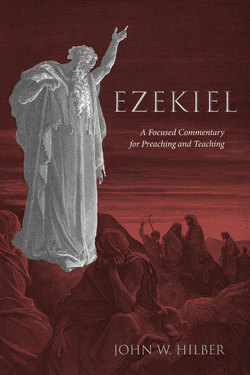Читать книгу Ezekiel - John W. Hilber - Страница 17
На сайте Литреса книга снята с продажи.
God’s Parting Judgment
ОглавлениеEzekiel 10:1–22
Ezekiel’s Message
The withdrawal of God’s presence results in reluctant yet destructive judgment.
Key Themes
• God’s judgment springs from the purity of his glory.
• God’s knowledge of human affairs is complete and penetrating.
• God’s gracious attributes render him reluctant to leave and judge.
Context in Ezekiel
Ezekiel 9:3 reported the first stage in the departure of God’s glory from the temple, as it moves from the cherubim over the ark in the Most Holy Place to the temple threshold. This first stage is repeated in Ezek 10:3 (the two scenes of Ezek 9 and 10 overlap), after a pause in Ezek 9:3b–11 to depict the anticipated judgment. The process of departure continues in Ezek 10:18–19 when the glory transfers to a cherub-born chariot, which carries God’s glory to the eastern gate of the temple complex before final departure (Ezek 11:22–23). Within this context, God reveals to Ezekiel further aspects of judgment associated with the departure of his presence. The intention of Ezekiel’s visionary experience is not to report a chronologically organized portrayal of the destruction of Jerusalem; rather, these are “scenes of judgment” that convey what is actually “behind the scenes” of the impending Babylonian siege and destruction of the city.
Interpretive Highlights
10:1 over the heads of the cherubim: The flow of the narrative is not easy to follow, because Ezek 10:1 introduces into the vision a depiction of God’s chariot-throne that is born by cherubim who differ from the cherubim over the ark of the covenant (Ezek 9:3; 10:4). That the cherubim spoken of in v. 1 are those of the chariot is clarified in v. 3, since they are stationed on the south side of the temple waiting for the glory of God to mount the chariot (Ezek 10:18). Details about these cherubim unfold as the vision focuses first on the judgment connected with their fiery presence (Ezek 10:2–8) and then on their transport of God’s glory further away from the temple (Ezek 10:9–22).
10:2 burning coals . . . scatter them over the city: The phrase translated “burning coals” is identical to the words for coals from the altar (Lev 16:12) and also God’s weapons as a divine warrior (Ps 18:12–13). The coals of the altar have the capacity to atone for sin (Isa 6:6–7), but in Ezekiel’s vision they destroy. The image of fire over the city might compare Jerusalem’s destruction with that of Sodom (Gen 19:24; cf. Ps 11:6), an association drawn upon by Ezekiel elsewhere (Ezek 16:46–49).
10:4–8 radiance of the glory . . . take fire: The vision of Ezek 1 climaxed in the description of God’s glorious radiance (Ezek 1:28). From this radiance, God called Ezekiel and also signaled his presence with his people in exile. The vision of Ezek 10 employs the theology of God’s glory to a different end, stressing that God’s radiant presence departs with destructive judgment (“voice . . . the Lord commanded”; vv. 5–6). So dangerous is the fire associated with God’s radiance that even the angelic “man of linen” dared not take it directly from such close proximity to the throne.70
10:12 Their entire bodies . . . full of eyes: For general discussion of the cherubim, see comments on Ezek 1; but here in chapter 10, there are three important distinctions to note.71 First, Ezekiel now recognizes the identity of these same creatures from his initial vision as “cherubim” (Ezek 10:20–22). Overwhelmed at the outset of his first visionary experience, it was not until he recognized the God of glory (Ezek 1:28) that he could surmise the identity of the living creatures—Ezekiel reckoned that they must be comparable to the cherubim guarding the ark in the Most Holy Place.
